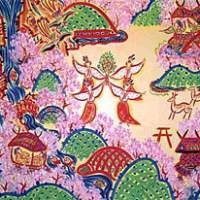Baijuan Teahouse in Setagaya
Closes in 8 days
"Albert Einstein and Niels Bohr debated," says painter Rei Torii, "but I agree with both of them -- their theories are all there in the 'The Story of Hotsuma Tsutae.' " In 2005, Torii published his own contemporary version of the "Hotsuma," an epic poem about Japan's mythical history, and likes to point out that the book and physicist Niels Bohr's quantum theory both trace the beginning of the universe to the action of "spinning". "The book and my paintings depict the Japanese spirit and explain the origins of space, time and matter," he says.
But his inspirations also extend back to the twisted decorations of Jomon Era pottery (14,000 B.C.) and the nature worship of the Heian Period's (794-1185) yamato-e paintings. "These were truly Japanese art forms since they viewed nature as something magnificent and powerful, yet vulnerable and in need of protection. Even today, for the Japanese, art is not something artificial made by humans, but beauty created by nature."
For the past 20 years, Torii has been creating colorful, energetic pieces on the theme of "Dancing in Paradise," and the 100-year-old Baijuan Teahouse ([03] 3221-4220), with its thatched roof and exquisite Japanese garden, is just the right setting for them.
"I'm connected to the universe and transfer its immense energy to the canvas through the paint brush with one focused slash, exactly how a samurai swung his sword. I never touch the pictures again." He doesn't have to: Like nature, they are perfect.


















With your current subscription plan you can comment on stories. However, before writing your first comment, please create a display name in the Profile section of your subscriber account page.